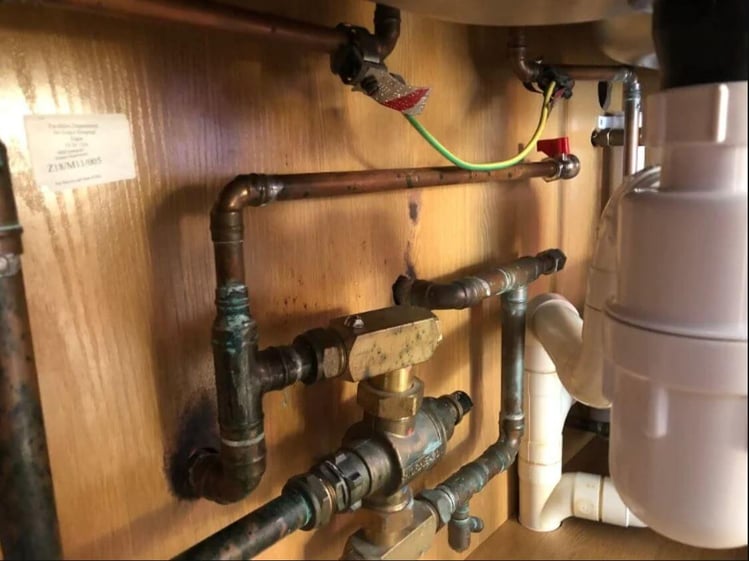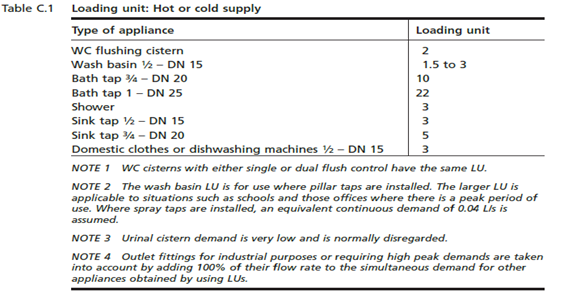When carrying out a project that involves installing domestic hot and cold-water systems, be it a refurbishment or a new build, the hot and cold pipework must be sized correctly for the system to function as designed.
In small simple installations, it is often accepted that pipes are sized based on previous experience and “common practice” methodology. For all other larger installations, the peak design flow rates should be calculated using a recognised method, such as in BS8558-2015 or BS EN 803 – 3.
Water Demand and impacts of incorrectly sized pipework
Peak demand is often overestimated at the design stage, which can bring problems, such as cost inefficiency and water quality problems. Incorrectly sized pipework can also produce unwanted noise within a system due to velocity being incorrect. Correctly sizing pipework also avoids scouring and undue wear of the pipework. Nonresidential buildings have significant water demand that is nearly always driven by the behaviour of their intended occupants.
This means that water use during daytime hours is a specific feature that differentiates the profile from that of residential buildings. In the UK, however, the Loading Unit (LU) approach is currently used to estimate design flow rates for both residential and non-residential buildings. Annex C of BS8558-2015 gives further guidance in this area.
Source, Flow, and frequency of your water
The source or intended supply also needs to be considered; is it mains fed? Boosted? Gravity fed? If boosted, is the booster set sized according to the intended design, and conversely is the pipework sized to consider expected booster pressure?
In most buildings, whether domestic or non-domestic, it is unlikely that all the assets or appliances within the building will be used simultaneously. For reasons of economy a simultaneous demand, which is less than the maximum demand from all appliances, should be provided for.
Usage and habits have changed in recent years, and drinking water demand has been down in previous years as drinking water is available from other sources, i.e., bottled water. Occupants are also more aware and mindful of waste. This demand can be calculated by relating to similarly designed installations or by using the application of probability theory using loading units.
Loading units are factors that consider the flow rate of the asset, the length of time in use, and the frequency of use. When making these calculations you need to take into account the number of each type of asset/appliance, and the length of the feed pipe being considered, which is then multiplied by the loading unit as shown in the table below which is an extract from BS8558-2015;
It is not applicable where usage is intensive, in such cases, it is necessary to establish the pattern of usage and appropriate peak flow demand for each case on its own merits.
Other considerations
The flow rate or velocity can also be affected by the various pipework fittings used within the system as well as elbows, tees, connectors, check valves, flow restrictors, and the type of tap being used.
The table below is an extract from BS8558-2015 and shows examples where the loss of flow may occur as a result:
Hot water return pipes must fulfill other hydraulic requirements and cannot be sized using this method. These pipes need to be sized to achieve the velocity required by national or manufacturer recommendations.
For assets that are fed by both hot and cold supplies, the loading model assumes that equal demand is met, however, this is certainly not when it comes to thermostatically controlled mixing taps for example, and this must be considered by not combining the hot and cold supply calculations and a separate calculation is used for each.
Conclusion
As with all Water Safety Projects, getting it right first time will save time, money, and resources. It is important when calculating pipework sizes that the Principal Designer considers:
- Intended usage of the system; will there be excessive use at certain times?
- Probable, Peak, and Simultaneous demand
- The implications of connecting to an existing system. How will this affect performance?
- Assets or appliances fed by both hot and cold water; separate hot and cold loading calculations are needed.
Feel free to reach out if you have any questions about this blog or if you would like to consult with one of our experts for further advice on water hygiene.
Editors Note: The information provided in this blog is correct at date of original publication - August 2023
© Water Hygiene Centre 2023











